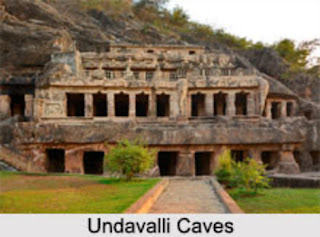Nestled in the lush landscape of Andhra Pradesh, India, the Undavalli Caves are an impressive example of rock-cut architecture that dates back to the 4th to 5th century CE. Carved out of solid sandstone, these caves hold significant historical, cultural, and artistic value, providing a fascinating glimpse into the ancient civilization that thrived in this region.
The Undavalli Caves are located approximately 8 kilometers from Amaravati, the historical capital of Andhra Pradesh, near the banks of the Krishna River. These caves are believed to have been created during the period of the Vishnukundina dynasty, known for its patronage of art and architecture. The caves serve as a testament to the remarkable craftsmanship and ingenuity of ancient artisans who transformed solid rock into elaborate structures.
The caves consist of a complex of monolithic structures, with the most significant being Cave 1. This grand chamber is renowned for its stunning architecture, which boasts a pillared hall with intricately carved columns. The most striking feature is the large sculpture of a reclining Buddha, measuring around 15 feet in length, depicted in the classic pose of relaxation. This image not only reflects the influence of Buddhism, which was prevalent in the region at the time, but also showcases the artistic excellence of the craftsmen.
Historically, the Undavalli Caves played a vital role in the propagation of Buddhism in South India. They served as monastic quarters for Buddhist monks who sought solitude and meditation away from the bustling life of the cities. The caves' serene environment, combined with their architectural brilliance, made them an ideal location for spiritual practices. Although the caves are predominantly associated with Buddhism, remnants of Hindu influence are also evident in the carvings and sculptures found throughout the site, highlighting the religious diversity of the era.
The artistic elegance of the Undavalli Caves reflects the cultural syncretism of ancient India. The intricate carvings depict various themes, including floral patterns, figurines of deities, and scenes from the lives of the Buddha. These artworks not only showcase the aesthetic sensibilities of the time but also provide insights into the socio-religious dynamics that shaped the region.
The history of the Undavalli Caves is intertwined with the broader historical context of South India, particularly during the rise and fall of dynasties that influenced the region. With the decline of Buddhism in South India, the caves gradually fell into obscurity. However, they were rediscovered in the 19th century, sparking renewed interest in their history. Today, they are recognized as an important heritage site and are protected by the Archaeological Survey of India.
In modern times, the Undavalli Caves continue to attract tourists and scholars alike, who come to marvel at their unique architecture and rich history. The site has become a focal point for those interested in ancient Indian art and architecture, drawing attention not only for its religious significance but also for its historical value.
Visiting the Undavalli Caves offers a unique opportunity to step back in time and witness the ingenuity of ancient Indian craftsmen. The blend of spirituality, artistry, and history encapsulated within these caves serves as a reminder of the vibrant cultural tapestry that has defined India for centuries. As such, the Undavalli Caves stand as a testament to a bygone era, reflecting the artistic and spiritual aspirations of an ancient civilization that continue to resonate with visitors today.
